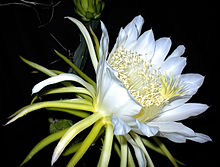Hylocereus: Difference between revisions
Appearance
Content deleted Content added
m r2.5.2) (robot Removing: sv:Hylocereus |
No edit summary |
||
| Line 24: | Line 24: | ||
|}} |
|}} |
||
[[Image:Pitaya bonsai.jpg|thumb|left|Examples of ''Hylocereus'' [[ |
[[Image:Pitaya bonsai.jpg|thumb|left|Examples of ''Hylocereus'' [[seedlings]]]] |
||
'''''Hylocereus''''' is a [[genus]] of [[cactus|cacti]], often referred to as [[nightblooming cactus]] (though the term is also used for the genus ''[[Selenicereus]]''). Several [[species]] have large edible [[fruit]]s, which are known as [[pitaya]] or dragonfruits. |
'''''Hylocereus''''' is a [[genus]] of [[cactus|cacti]], often referred to as [[nightblooming cactus]] (though the term is also used for the genus ''[[Selenicereus]]''). Several [[species]] have large edible [[fruit]]s, which are known as [[pitaya]] or dragonfruits. |
||
Revision as of 01:55, 2 January 2012
| Hylocereus | |
|---|---|

| |
| Hylocereus undatus | |
| Scientific classification | |
| Kingdom: | |
| (unranked): | |
| (unranked): | |
| (unranked): | |
| Order: | |
| Family: | |
| Subfamily: | |
| Tribe: | |
| Genus: | Hylocereus |
| Species | |
| |

Hylocereus is a genus of cacti, often referred to as nightblooming cactus (though the term is also used for the genus Selenicereus). Several species have large edible fruits, which are known as pitaya or dragonfruits.
Taxonomy
A difficult genus with poorly understood species, due to their wide range and variability. Closely related to Selenicereus. The genus Wilmattea Britton & Rose has been brought into synonymy with Hylocereus. Besides, some would include Hylocereus in the genus Selenicereus.
Summary of the species
- Hylocereus calcaratus - Costa Rica. Stems soft, green with distinctly lobed stems. Flowers 35–37 cm long, 20–30 cm wide.
- Hylocereus costaricensis - (incl Hylocereus polyrhizus of gardens) Costa Rica and Nicaragua to Peru. Stems waxy-white without horny margins. Flowers ca. 30 cm long with large bracts, usually with purple margins. Fruit red with purple pulpa.
- Hylocereus escuintlensis Guatemala. Stems green not glaucous, brown-margined. Flowers 28–31 cm long, 24–36 cm wide.
- Hylocereus megalanthus - Stems green, slender without horny margins. Flowers 30–38 cm long with large flattened tubercles and small bracts. Flowers similar to Selenicereus. Fruit yellow.
- Hylocereus minutiflorus - Guatemala, Honduras. Stems green. Flowers with rigid spines at base of flower, 5 cm long, 8–9 cm wide, white.
- Hylocereus monacanthus - (incl. Hylocereus lemairei) Costa Rica to N South America. Stems gray-green without horny margins. Flowers ca 30 cm long, petals white, tinged pinkish near base or entirely pink. Tube with distant bracts. Stigma lobes usually forked. Fruit red with purple pulpa.

- Hylocereus ocamponis - (incl. Hylocereus guatemalense, Hylocereus purpursii) Mexico & Guatemala. Stems white-waxy, margins horny, spines needle-like, to 12 mm long. Flowers 25–32 cm long with white inner petals. Bracts overlapping, with purple margins.
- Hylocereus setaceus - Stems green without horny margins, rather spiny. Flowers 19–22 cm with small tubercles and bracts. Flowers similar to Selenicereus. Fruit red.
- Hylocereus stenopterus- Costa Rica. Stems thin, soft, green. Flowers 9–10 cm long, 13–15 cm wide, tube short, tepals purplish red.
- Hylocereus triangularis (incl. Hylocereus cubensis). Cuba, Haiti, Dominican Republic, Jamaica. Stems green without horny margins, slender. Flowers ca. 20 cm long, base with wide overlapping scales.
- Hylocereus trigonus - (incl. Hylocereus napoleonis, Hylocereus antiguensis). West Indies (Puerto Rico south to Grenada). Stems green without horny margins. Flowers ca. 22 cm long, 21 cm wide, base with small, narrow, widely spaced scales, sometimes spiny. Fruit red.
- Hylocereus undatus Native habitat unknown and maybe of hybrid origin. Stems green, margins undulate and horny. Flowers 25–30 cm long, white with green outer tepals and bracts. Fruit red with white pulpa.
See also
- Epiphyllum - another cactus genus yielding edible fruits
Wikispecies has information related to Hylocereus.
